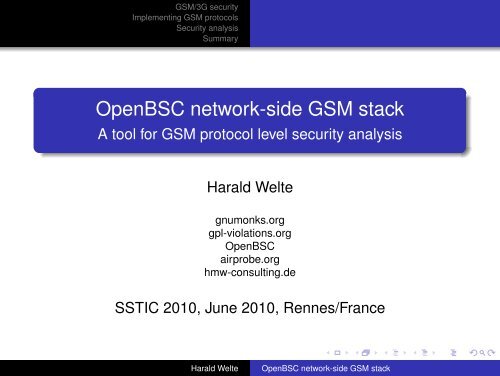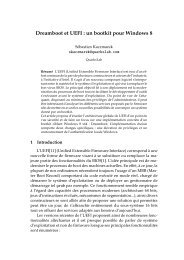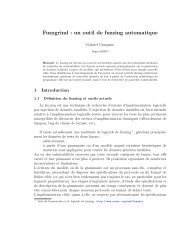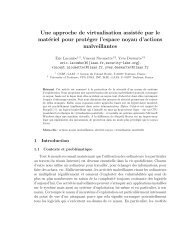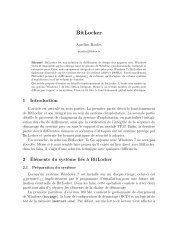OpenBSC network-side GSM stack - A tool for GSM protocol ... - Sstic
OpenBSC network-side GSM stack - A tool for GSM protocol ... - Sstic
OpenBSC network-side GSM stack - A tool for GSM protocol ... - Sstic
You also want an ePaper? Increase the reach of your titles
YUMPU automatically turns print PDFs into web optimized ePapers that Google loves.
<strong>GSM</strong>/3G security<br />
Implementing <strong>GSM</strong> <strong>protocol</strong>s<br />
Security analysis<br />
Summary<br />
<strong>OpenBSC</strong> <strong>network</strong>-<strong>side</strong> <strong>GSM</strong> <strong>stack</strong><br />
A <strong>tool</strong> <strong>for</strong> <strong>GSM</strong> <strong>protocol</strong> level security analysis<br />
Harald Welte<br />
gnumonks.org<br />
gpl-violations.org<br />
<strong>OpenBSC</strong><br />
airprobe.org<br />
hmw-consulting.de<br />
SSTIC 2010, June 2010, Rennes/France<br />
Harald Welte<br />
<strong>OpenBSC</strong> <strong>network</strong>-<strong>side</strong> <strong>GSM</strong> <strong>stack</strong>
Outline<br />
<strong>GSM</strong>/3G security<br />
Implementing <strong>GSM</strong> <strong>protocol</strong>s<br />
Security analysis<br />
Summary<br />
1 <strong>GSM</strong>/3G security<br />
The closed <strong>GSM</strong> industry<br />
Security implications<br />
The <strong>GSM</strong> <strong>network</strong><br />
The <strong>GSM</strong> <strong>protocol</strong>s<br />
2 Implementing <strong>GSM</strong> <strong>protocol</strong>s<br />
Getting started<br />
Timeline<br />
<strong>OpenBSC</strong><br />
3 Security analysis<br />
Theory<br />
Observations<br />
<strong>GSM</strong> Protocol Fuzzing<br />
4 Summary<br />
What we’ve learned<br />
Where we go fromHarald here Welte<br />
<strong>OpenBSC</strong> <strong>network</strong>-<strong>side</strong> <strong>GSM</strong> <strong>stack</strong>
<strong>GSM</strong>/3G security<br />
Implementing <strong>GSM</strong> <strong>protocol</strong>s<br />
Security analysis<br />
Summary<br />
About the speaker<br />
Using + playing with Linux since 1994<br />
Kernel / bootloader / driver / firmware development since<br />
1999<br />
IT security expert, focus on <strong>network</strong> <strong>protocol</strong> security<br />
Core developer of Linux packet filter netfilter/iptables<br />
Board-level Electrical Engineering<br />
Always looking <strong>for</strong> interesting <strong>protocol</strong>s (RFID, DECT,<br />
<strong>GSM</strong>)<br />
Harald Welte<br />
<strong>OpenBSC</strong> <strong>network</strong>-<strong>side</strong> <strong>GSM</strong> <strong>stack</strong>
<strong>GSM</strong>/3G security<br />
Implementing <strong>GSM</strong> <strong>protocol</strong>s<br />
Security analysis<br />
Summary<br />
<strong>GSM</strong>/3G <strong>protocol</strong> security<br />
The closed <strong>GSM</strong> industry<br />
Security implications<br />
The <strong>GSM</strong> <strong>network</strong><br />
The <strong>GSM</strong> <strong>protocol</strong>s<br />
Observation<br />
Both <strong>GSM</strong>/3G and TCP/IP <strong>protocol</strong> specs are publicly<br />
available<br />
The Internet <strong>protocol</strong> <strong>stack</strong> (Ethernet/Wifi/TCP/IP) receives<br />
lots of scrutiny<br />
<strong>GSM</strong> <strong>network</strong>s are as widely deployed as the Internet<br />
Yet, <strong>GSM</strong>/3G <strong>protocol</strong>s receive no such scrutiny!<br />
There are reasons <strong>for</strong> that:<br />
<strong>GSM</strong> industry is extremely closed (and closed-minded)<br />
Only about 4 closed-source <strong>protocol</strong> <strong>stack</strong> implementations<br />
<strong>GSM</strong> chipset makers never release any hardware<br />
documentation<br />
Harald Welte<br />
<strong>OpenBSC</strong> <strong>network</strong>-<strong>side</strong> <strong>GSM</strong> <strong>stack</strong>
<strong>GSM</strong>/3G security<br />
Implementing <strong>GSM</strong> <strong>protocol</strong>s<br />
Security analysis<br />
Summary<br />
The closed <strong>GSM</strong> industry<br />
Handset manufacturing <strong>side</strong><br />
The closed <strong>GSM</strong> industry<br />
Security implications<br />
The <strong>GSM</strong> <strong>network</strong><br />
The <strong>GSM</strong> <strong>protocol</strong>s<br />
Only very few companies build <strong>GSM</strong>/3.5G baseband chips<br />
today<br />
Those companies buy the operating system kernel and the<br />
<strong>protocol</strong> <strong>stack</strong> from third parties<br />
Only very few handset makers are large enough to<br />
become a customer<br />
Even they only get limited access to hardware<br />
documentation<br />
Even they never really get access to the firmware source<br />
Harald Welte<br />
<strong>OpenBSC</strong> <strong>network</strong>-<strong>side</strong> <strong>GSM</strong> <strong>stack</strong>
<strong>GSM</strong>/3G security<br />
Implementing <strong>GSM</strong> <strong>protocol</strong>s<br />
Security analysis<br />
Summary<br />
The closed <strong>GSM</strong> industry<br />
Network manufacturing <strong>side</strong><br />
The closed <strong>GSM</strong> industry<br />
Security implications<br />
The <strong>GSM</strong> <strong>network</strong><br />
The <strong>GSM</strong> <strong>protocol</strong>s<br />
Only very few companies build <strong>GSM</strong> <strong>network</strong> equipment<br />
Basically only Ericsson, Nokia-Siemens, Alcatel-Lucent and<br />
Huawei<br />
Exception: Small equipment manufacturers <strong>for</strong> picocell /<br />
nanocell / femtocells / measurement devices and law<br />
en<strong>for</strong>cement equipment<br />
Only operators buy equipment from them<br />
Since the quantities are low, the prices are extremely high<br />
e.g. <strong>for</strong> a BTS, easily 10-40k EUR<br />
Harald Welte<br />
<strong>OpenBSC</strong> <strong>network</strong>-<strong>side</strong> <strong>GSM</strong> <strong>stack</strong>
<strong>GSM</strong>/3G security<br />
Implementing <strong>GSM</strong> <strong>protocol</strong>s<br />
Security analysis<br />
Summary<br />
The closed <strong>GSM</strong> industry<br />
Operator <strong>side</strong><br />
The closed <strong>GSM</strong> industry<br />
Security implications<br />
The <strong>GSM</strong> <strong>network</strong><br />
The <strong>GSM</strong> <strong>protocol</strong>s<br />
Operators are mainly banks today<br />
Typical operator outsources<br />
Network planning / deployment / servicing<br />
Even Billing!<br />
Operator just knows the closed equipment as shipped by<br />
manufacturer<br />
Very few people at an operator have knowledge of the<br />
<strong>protocol</strong> beyond what’s needed <strong>for</strong> operations and<br />
maintenance<br />
Harald Welte<br />
<strong>OpenBSC</strong> <strong>network</strong>-<strong>side</strong> <strong>GSM</strong> <strong>stack</strong>
<strong>GSM</strong>/3G security<br />
Implementing <strong>GSM</strong> <strong>protocol</strong>s<br />
Security analysis<br />
Summary<br />
<strong>GSM</strong> is more than phone calls<br />
The closed <strong>GSM</strong> industry<br />
Security implications<br />
The <strong>GSM</strong> <strong>network</strong><br />
The <strong>GSM</strong> <strong>protocol</strong>s<br />
Listening to phone calls is boring...<br />
Machine-to-Machine (M2M) communication<br />
BMW can unlock/open your car via <strong>GSM</strong><br />
Alarm systems often report via <strong>GSM</strong><br />
Smart Metering (Utility companies)<br />
<strong>GSM</strong>-R / European Train Control System<br />
Vending machines report that their cash box is full<br />
Control if wind-mills supply power into the grid<br />
Transaction numbers <strong>for</strong> electronic banking<br />
Harald Welte<br />
<strong>OpenBSC</strong> <strong>network</strong>-<strong>side</strong> <strong>GSM</strong> <strong>stack</strong>
<strong>GSM</strong>/3G security<br />
Implementing <strong>GSM</strong> <strong>protocol</strong>s<br />
Security analysis<br />
Summary<br />
The closed <strong>GSM</strong> industry<br />
Security implications<br />
The closed <strong>GSM</strong> industry<br />
Security implications<br />
The <strong>GSM</strong> <strong>network</strong><br />
The <strong>GSM</strong> <strong>protocol</strong>s<br />
The security implications of the closed <strong>GSM</strong> industry are:<br />
Almost no people who have detailed technical knowledge<br />
out<strong>side</strong> the <strong>protocol</strong> <strong>stack</strong> or <strong>GSM</strong> <strong>network</strong> equipment<br />
manufacturers<br />
No independent research on <strong>protocol</strong>-level security<br />
If there’s security research at all, then only theoretical (like<br />
the A5/2 and A5/1 cryptanalysis)<br />
Or on application level (e.g. mobile malware)<br />
No open source <strong>protocol</strong> implementations<br />
which are key <strong>for</strong> making more people learn about the<br />
<strong>protocol</strong>s<br />
which enable quick prototyping/testing by modifying existing<br />
code<br />
Harald Welte<br />
<strong>OpenBSC</strong> <strong>network</strong>-<strong>side</strong> <strong>GSM</strong> <strong>stack</strong>
<strong>GSM</strong>/3G security<br />
Implementing <strong>GSM</strong> <strong>protocol</strong>s<br />
Security analysis<br />
Summary<br />
The closed <strong>GSM</strong> industry<br />
My self-proclaimed mission<br />
The closed <strong>GSM</strong> industry<br />
Security implications<br />
The <strong>GSM</strong> <strong>network</strong><br />
The <strong>GSM</strong> <strong>protocol</strong>s<br />
Mission: Bring TCP/IP/Internet security knowledge to <strong>GSM</strong><br />
Create <strong>tool</strong>s to enable independent/public IT Security<br />
community to examine <strong>GSM</strong><br />
Try to close the estimated 10 year gap between the state of<br />
security technology on the Internet vs. <strong>GSM</strong> <strong>network</strong>s<br />
Industry thinks in terms of walled garden and phones<br />
behaving like specified<br />
No proper incident response strategies!<br />
No packet filters, firewalls, intrusion detection on <strong>GSM</strong><br />
<strong>protocol</strong> level<br />
General public assumes <strong>GSM</strong> <strong>network</strong>s are safer than<br />
Internet<br />
Harald Welte<br />
<strong>OpenBSC</strong> <strong>network</strong>-<strong>side</strong> <strong>GSM</strong> <strong>stack</strong>
<strong>GSM</strong>/3G security<br />
Implementing <strong>GSM</strong> <strong>protocol</strong>s<br />
Security analysis<br />
Summary<br />
The closed <strong>GSM</strong> industry<br />
Areas of interest <strong>for</strong> Security research<br />
The closed <strong>GSM</strong> industry<br />
Security implications<br />
The <strong>GSM</strong> <strong>network</strong><br />
The <strong>GSM</strong> <strong>protocol</strong>s<br />
Specification problems<br />
Encryption optional, weak and only on the Um interface<br />
Lack of mutual authentication<br />
Silent calls <strong>for</strong> pin-pointing a phone<br />
RRLP and SUPL to obtain GPS coordinates of phone<br />
Implementation problems<br />
TMSI in<strong>for</strong>mation leak on <strong>network</strong> change<br />
TLV parsers that have never seen invalid packets<br />
Obscure options in spec lead to rarely-tested/used code<br />
paths<br />
Operation problems<br />
VLR overflow leading to paging-by-IMSI<br />
TMSI re-allocation too infrequent<br />
Networks/Cells without frequency hopping<br />
Harald Welte<br />
<strong>OpenBSC</strong> <strong>network</strong>-<strong>side</strong> <strong>GSM</strong> <strong>stack</strong>
<strong>GSM</strong>/3G security<br />
Implementing <strong>GSM</strong> <strong>protocol</strong>s<br />
Security analysis<br />
Summary<br />
Security analysis of <strong>GSM</strong><br />
How would you get started?<br />
The closed <strong>GSM</strong> industry<br />
Security implications<br />
The <strong>GSM</strong> <strong>network</strong><br />
The <strong>GSM</strong> <strong>protocol</strong>s<br />
If you were to start with <strong>GSM</strong> <strong>protocol</strong> level security analysis,<br />
where and how would you start?<br />
On the handset <strong>side</strong>?<br />
Difficult since <strong>GSM</strong> firmware and <strong>protocol</strong> <strong>stack</strong>s are closed<br />
and proprietary<br />
Even if you want to write your own <strong>protocol</strong> <strong>stack</strong>, the layer<br />
1 hardware and signal processing is closed and<br />
undocumented, too<br />
Publicly known attempts<br />
The TSM30 project as part of the THC <strong>GSM</strong> project<br />
mados, an alternative OS <strong>for</strong> Nokia DTC3 phones<br />
none of those projects successful so far<br />
Harald Welte<br />
<strong>OpenBSC</strong> <strong>network</strong>-<strong>side</strong> <strong>GSM</strong> <strong>stack</strong>
<strong>GSM</strong>/3G security<br />
Implementing <strong>GSM</strong> <strong>protocol</strong>s<br />
Security analysis<br />
Summary<br />
Security analysis of <strong>GSM</strong><br />
How would you get started?<br />
The closed <strong>GSM</strong> industry<br />
Security implications<br />
The <strong>GSM</strong> <strong>network</strong><br />
The <strong>GSM</strong> <strong>protocol</strong>s<br />
If you were to start with <strong>GSM</strong> <strong>protocol</strong> level security analysis,<br />
where and how would you start?<br />
On the <strong>network</strong> <strong>side</strong>?<br />
Difficult since equipment is not easily available and<br />
normally extremely expensive<br />
However, <strong>network</strong> is very modular and has many<br />
standardized/documented interfaces<br />
Thus, if BTS equipment is available, much easier/faster<br />
progress<br />
Harald Welte<br />
<strong>OpenBSC</strong> <strong>network</strong>-<strong>side</strong> <strong>GSM</strong> <strong>stack</strong>
<strong>GSM</strong>/3G security<br />
Implementing <strong>GSM</strong> <strong>protocol</strong>s<br />
Security analysis<br />
Summary<br />
Security analysis of <strong>GSM</strong><br />
The bootstrapping process<br />
The closed <strong>GSM</strong> industry<br />
Security implications<br />
The <strong>GSM</strong> <strong>network</strong><br />
The <strong>GSM</strong> <strong>protocol</strong>s<br />
Read <strong>GSM</strong> specs (> 1000 PDF documents) ;)<br />
Gradually grow knowledge about the <strong>protocol</strong>s<br />
Obtain actual <strong>GSM</strong> <strong>network</strong> equipment (BTS)<br />
Try to get actual <strong>protocol</strong> traces as examples<br />
Start a complete <strong>protocol</strong> <strong>stack</strong> implementation from<br />
scratch<br />
Finally, go and play with <strong>GSM</strong> <strong>protocol</strong> security<br />
Harald Welte<br />
<strong>OpenBSC</strong> <strong>network</strong>-<strong>side</strong> <strong>GSM</strong> <strong>stack</strong>
The <strong>GSM</strong> <strong>network</strong><br />
<strong>GSM</strong>/3G security<br />
Implementing <strong>GSM</strong> <strong>protocol</strong>s<br />
Security analysis<br />
Summary<br />
The closed <strong>GSM</strong> industry<br />
Security implications<br />
The <strong>GSM</strong> <strong>network</strong><br />
The <strong>GSM</strong> <strong>protocol</strong>s<br />
Harald Welte<br />
<strong>OpenBSC</strong> <strong>network</strong>-<strong>side</strong> <strong>GSM</strong> <strong>stack</strong>
<strong>GSM</strong>/3G security<br />
Implementing <strong>GSM</strong> <strong>protocol</strong>s<br />
Security analysis<br />
Summary<br />
<strong>GSM</strong> <strong>network</strong> components<br />
The closed <strong>GSM</strong> industry<br />
Security implications<br />
The <strong>GSM</strong> <strong>network</strong><br />
The <strong>GSM</strong> <strong>protocol</strong>s<br />
The BSS (Base Station Subsystem)<br />
MS (Mobile Station): Your phone<br />
BTS (Base Transceiver Station): The cell tower<br />
BSC (Base Station Controller): Controlling up to hundreds<br />
of BTS<br />
The NSS (Network Sub System)<br />
MSC (Mobile Switching Center): The central switch<br />
HLR (Home Location Register): Database of subscribers<br />
AUC (Authentication Center): Database of authentication<br />
keys<br />
VLR (Visitor Location Register): For roaming users<br />
EIR (Equipment Identity Register): To block stolen phones<br />
Harald Welte<br />
<strong>OpenBSC</strong> <strong>network</strong>-<strong>side</strong> <strong>GSM</strong> <strong>stack</strong>
<strong>GSM</strong>/3G security<br />
Implementing <strong>GSM</strong> <strong>protocol</strong>s<br />
Security analysis<br />
Summary<br />
<strong>GSM</strong> <strong>network</strong> interfaces<br />
The closed <strong>GSM</strong> industry<br />
Security implications<br />
The <strong>GSM</strong> <strong>network</strong><br />
The <strong>GSM</strong> <strong>protocol</strong>s<br />
Um: Interface between MS and BTS<br />
the only interface that is specified over radio<br />
A-bis: Interface between BTS and BSC<br />
A: Interface between BSC and MSC<br />
B: Interface between MSC and other MSC<br />
<strong>GSM</strong> <strong>network</strong>s are a prime example of an asymmetric<br />
distributed <strong>network</strong>, very different from the end-to-end<br />
transparent IP <strong>network</strong>.<br />
Harald Welte<br />
<strong>OpenBSC</strong> <strong>network</strong>-<strong>side</strong> <strong>GSM</strong> <strong>stack</strong>
<strong>GSM</strong>/3G security<br />
Implementing <strong>GSM</strong> <strong>protocol</strong>s<br />
Security analysis<br />
Summary<br />
<strong>GSM</strong> <strong>network</strong> <strong>protocol</strong>s<br />
On the Um interface<br />
The closed <strong>GSM</strong> industry<br />
Security implications<br />
The <strong>GSM</strong> <strong>network</strong><br />
The <strong>GSM</strong> <strong>protocol</strong>s<br />
Layer 1: Radio Layer, TS 04.04<br />
Layer 2: LAPDm, TS 04.06<br />
Layer 3: Radio Resource, Mobility Management, Call<br />
Control: TS 04.08<br />
Layer 4+: <strong>for</strong> USSD, SMS, LCS, ...<br />
Harald Welte<br />
<strong>OpenBSC</strong> <strong>network</strong>-<strong>side</strong> <strong>GSM</strong> <strong>stack</strong>
<strong>GSM</strong>/3G security<br />
Implementing <strong>GSM</strong> <strong>protocol</strong>s<br />
Security analysis<br />
Summary<br />
<strong>GSM</strong> <strong>network</strong> <strong>protocol</strong>s<br />
On the A-bis interface<br />
The closed <strong>GSM</strong> industry<br />
Security implications<br />
The <strong>GSM</strong> <strong>network</strong><br />
The <strong>GSM</strong> <strong>protocol</strong>s<br />
Layer 1: Typically E1 line, TS 08.54<br />
Layer 2: A variant of ISDN LAPD with fixed TEI’s, TS 08.56<br />
Layer 3: OML (Organization and Maintenance Layer, TS<br />
12.21)<br />
Layer 3: RSL (Radio Signalling Link, TS 08.58)<br />
Layer 4+: transparent messages that are sent to the MS<br />
via Um<br />
Harald Welte<br />
<strong>OpenBSC</strong> <strong>network</strong>-<strong>side</strong> <strong>GSM</strong> <strong>stack</strong>
<strong>GSM</strong>/3G security<br />
Implementing <strong>GSM</strong> <strong>protocol</strong>s<br />
Security analysis<br />
Summary<br />
Implementing <strong>GSM</strong> <strong>protocol</strong>s<br />
How I got started!<br />
Getting started<br />
Timeline<br />
<strong>OpenBSC</strong><br />
In 2006 I bought an old BTS (Siemens BS-11) on eBay<br />
This is 48kg <strong>GSM</strong>900 BTS with 2 TRX at 2W output power<br />
(each)<br />
I didn’t have much time at the time (day job at Openmoko)<br />
Started to read up on <strong>GSM</strong> specs whenever I could<br />
Bought a HFC-E1 based PCI E1 controller, has mISDN<br />
kernel support<br />
Found somebody in the <strong>GSM</strong> industry who provided<br />
<strong>protocol</strong> traces<br />
In September 2008, we were first able to make the BTS<br />
active and see it on a phone<br />
Harald Welte<br />
<strong>OpenBSC</strong> <strong>network</strong>-<strong>side</strong> <strong>GSM</strong> <strong>stack</strong>
<strong>GSM</strong>/3G security<br />
Implementing <strong>GSM</strong> <strong>protocol</strong>s<br />
Security analysis<br />
Summary<br />
Implementing <strong>GSM</strong> <strong>protocol</strong>s<br />
Timeline<br />
Getting started<br />
Timeline<br />
<strong>OpenBSC</strong><br />
November 2008: I started the development of <strong>OpenBSC</strong><br />
December 2008: we did a first demo at 25C3<br />
January 2009: we had full voice call support<br />
Q1/2009: Add support <strong>for</strong> ip.access nanoBTS<br />
June 2009: I started with actual security related stuff<br />
August 2009: We had the first field test with 2BTS and ><br />
860 phones<br />
Q1/2010: The first 25 <strong>OpenBSC</strong> instances running in a<br />
commercial <strong>network</strong><br />
Harald Welte<br />
<strong>OpenBSC</strong> <strong>network</strong>-<strong>side</strong> <strong>GSM</strong> <strong>stack</strong>
<strong>GSM</strong>/3G security<br />
Implementing <strong>GSM</strong> <strong>protocol</strong>s<br />
Security analysis<br />
Summary<br />
Security analysis of <strong>GSM</strong><br />
<strong>OpenBSC</strong><br />
Getting started<br />
Timeline<br />
<strong>OpenBSC</strong><br />
What is <strong>OpenBSC</strong><br />
A <strong>GSM</strong> <strong>network</strong> in a box software<br />
Implements minimal subset of BSC, MSC, HLR, SMSC<br />
Is Free and Open Source Software licensed under GNU<br />
GPL<br />
Supports Siemens BS-11 BTS (E1) and ip.access<br />
nanoBTS (IP based)<br />
Has classic 2G signalling, voice and SMS support<br />
Implements various <strong>GSM</strong> <strong>protocol</strong>s like<br />
A-bis RSL (TS 08.58) and OML (TS 12.21)<br />
TS 04.08 Radio Resource, Mobility Management, Call<br />
Control<br />
TS 04.11 Short Message Service<br />
Harald Welte<br />
<strong>OpenBSC</strong> <strong>network</strong>-<strong>side</strong> <strong>GSM</strong> <strong>stack</strong>
<strong>GSM</strong>/3G security<br />
Implementing <strong>GSM</strong> <strong>protocol</strong>s<br />
Security analysis<br />
Summary<br />
Security analysis of <strong>GSM</strong><br />
<strong>OpenBSC</strong><br />
Getting started<br />
Timeline<br />
<strong>OpenBSC</strong><br />
<strong>OpenBSC</strong> features<br />
Run a small <strong>GSM</strong> <strong>network</strong> with 1-n BTS and <strong>OpenBSC</strong><br />
No need <strong>for</strong> MSC/HLR/AUC/...<br />
No need <strong>for</strong> your own SIM cards<br />
Establish signalling channels<br />
Make incoming and outgoing voice calls between phones<br />
Send/receive SMS between phones<br />
Connect to ISDN PBX or public ISDN via Linux Call Router<br />
Telnet console with Cisco-style interface<br />
Harald Welte<br />
<strong>OpenBSC</strong> <strong>network</strong>-<strong>side</strong> <strong>GSM</strong> <strong>stack</strong>
<strong>GSM</strong>/3G security<br />
Implementing <strong>GSM</strong> <strong>protocol</strong>s<br />
Security analysis<br />
Summary<br />
Known <strong>GSM</strong> security problems<br />
Scientific papers, etc<br />
Theory<br />
Observations<br />
<strong>GSM</strong> Protocol Fuzzing<br />
No mutual authentication between phone and <strong>network</strong><br />
leads to rogue <strong>network</strong> attacks<br />
leads to man-in-the-middle attacks<br />
is what enables IMSI-catchers<br />
Weak encryption algorithms<br />
Encryption is optional, user does never know when it’s<br />
active or not<br />
DoS of the RACH by means of channel request flooding<br />
RRLP (Radio Resource Location Protocol)<br />
the <strong>network</strong> can obtain GPS fix or even raw <strong>GSM</strong> data from<br />
the phone<br />
combine that with the <strong>network</strong> not needing to authenticate<br />
itself<br />
Harald Welte<br />
<strong>OpenBSC</strong> <strong>network</strong>-<strong>side</strong> <strong>GSM</strong> <strong>stack</strong>
<strong>GSM</strong>/3G security<br />
Implementing <strong>GSM</strong> <strong>protocol</strong>s<br />
Security analysis<br />
Summary<br />
Interesting observations<br />
Learned from implementing the <strong>stack</strong><br />
Theory<br />
Observations<br />
<strong>GSM</strong> Protocol Fuzzing<br />
While developing <strong>OpenBSC</strong>, we observed a number of<br />
interesting<br />
Many phones use their TMSI from the old <strong>network</strong> when<br />
they roam to a new <strong>network</strong><br />
Various phones crash when confronted with incorrect<br />
messages. We didn’t even start to intentionally send<br />
incorrect messages (!)<br />
There are tons of obscure options on the <strong>GSM</strong> spec which<br />
no real <strong>network</strong> uses. Potential attack vector by using<br />
rarely tested code paths.<br />
Harald Welte<br />
<strong>OpenBSC</strong> <strong>network</strong>-<strong>side</strong> <strong>GSM</strong> <strong>stack</strong>
<strong>GSM</strong>/3G security<br />
Implementing <strong>GSM</strong> <strong>protocol</strong>s<br />
Security analysis<br />
Summary<br />
<strong>GSM</strong> Protocol Fuzzing<br />
Theoretical basis<br />
Theory<br />
Observations<br />
<strong>GSM</strong> Protocol Fuzzing<br />
How to do <strong>GSM</strong> <strong>protocol</strong> fuzzing<br />
From the handset to the <strong>network</strong><br />
Basically impossible due to closeness of baseband<br />
However, some incomplete projects working on it<br />
From the <strong>network</strong> <strong>side</strong><br />
Easy in case of rogue <strong>network</strong> attacks<br />
Fuzzing target is the <strong>GSM</strong> <strong>stack</strong> in the baseband processor<br />
As an A-bis man in the middle<br />
Needs access to an A-bis interface of an actual <strong>network</strong><br />
Very attractive, since no encryption and ability to fuzz both<br />
<strong>network</strong> and handset<br />
Harald Welte<br />
<strong>OpenBSC</strong> <strong>network</strong>-<strong>side</strong> <strong>GSM</strong> <strong>stack</strong>
A-bis injection<br />
<strong>for</strong> A-bis over IP<br />
<strong>GSM</strong>/3G security<br />
Implementing <strong>GSM</strong> <strong>protocol</strong>s<br />
Security analysis<br />
Summary<br />
Theory<br />
Observations<br />
<strong>GSM</strong> Protocol Fuzzing<br />
How to do inject messages into A-bis over IP?<br />
Problem<br />
A-bis/IP uses one TCP connection <strong>for</strong> OML and RSL<br />
messages<br />
OML initialization is essential <strong>for</strong> BTS to become<br />
operational<br />
TCP makes insertion of additional messages relatively hard<br />
Solution: Build an A-bis injection proxy<br />
Transparently pass OML and RSL packets between BTS<br />
and BSC<br />
Add additional stateless UDP sockets <strong>for</strong> injecting<br />
messages, one socket each <strong>for</strong><br />
injecting OML/RSL to the <strong>network</strong><br />
injecting OML/RSL to the BTS<br />
Harald Welte<br />
<strong>OpenBSC</strong> <strong>network</strong>-<strong>side</strong> <strong>GSM</strong> <strong>stack</strong>
<strong>GSM</strong>/3G security<br />
Implementing <strong>GSM</strong> <strong>protocol</strong>s<br />
Security analysis<br />
Summary<br />
A-bis Injection Proxy<br />
Principle of operation<br />
Theory<br />
Observations<br />
<strong>GSM</strong> Protocol Fuzzing<br />
Proxy needs to be brought between BTS and BSC<br />
Luckily, A-bis/IP SSL support not always used<br />
Thus, physical access to the Ethernet link sufficient<br />
Configure system with two interfaces<br />
BSC-facing interface has IP of BTS<br />
BTS-facing interface has IP of BSC / default gw<br />
BTS will make TCP connection to proxy<br />
proxy will make independent TCP connection to BSC<br />
Harald Welte<br />
<strong>OpenBSC</strong> <strong>network</strong>-<strong>side</strong> <strong>GSM</strong> <strong>stack</strong>
<strong>GSM</strong>/3G security<br />
Implementing <strong>GSM</strong> <strong>protocol</strong>s<br />
Security analysis<br />
Summary<br />
scapy <strong>GSM</strong> support<br />
The actual fuzzing<br />
Theory<br />
Observations<br />
<strong>GSM</strong> Protocol Fuzzing<br />
How to actually craft the packets <strong>for</strong> the fuzzing<br />
<strong>GSM</strong> has many, many <strong>protocol</strong>s<br />
Writing custom code will be a hard-coded special case <strong>for</strong><br />
each of them<br />
Solution: Use scapy and implement the <strong>GSM</strong> <strong>protocol</strong>s as<br />
scapy Layers<br />
IPA <strong>protocol</strong> header<br />
RSL <strong>protocol</strong> layer<br />
RLL data indication / data request<br />
<strong>GSM</strong> 04.08 RR / MM / CC messages<br />
Harald Welte<br />
<strong>OpenBSC</strong> <strong>network</strong>-<strong>side</strong> <strong>GSM</strong> <strong>stack</strong>
<strong>GSM</strong>/3G security<br />
Implementing <strong>GSM</strong> <strong>protocol</strong>s<br />
Security analysis<br />
Summary<br />
<strong>OpenBSC</strong> silent calls<br />
A more elegant fuzzing interface<br />
Theory<br />
Observations<br />
<strong>GSM</strong> Protocol Fuzzing<br />
Injection at the A-bis level has many problems<br />
you can only do it while a call is active<br />
you simply piggy-back on existing RR connections<br />
The <strong>OpenBSC</strong> silent call feature can help<br />
we use <strong>OpenBSC</strong> to establish a RR connection<br />
in the <strong>GSM</strong> master/slave model, the phone will not close a<br />
connection unless told to do so<br />
we then send arbitrary data to the phone and receive its<br />
responses<br />
this currently only works from within <strong>OpenBSC</strong>, but we’ll<br />
provide UDP injection sockets soon<br />
Harald Welte<br />
<strong>OpenBSC</strong> <strong>network</strong>-<strong>side</strong> <strong>GSM</strong> <strong>stack</strong>
Summary<br />
What we’ve learned<br />
<strong>GSM</strong>/3G security<br />
Implementing <strong>GSM</strong> <strong>protocol</strong>s<br />
Security analysis<br />
Summary<br />
What we’ve learned<br />
Where we go from here<br />
Where we go from here<br />
Further Reading<br />
The <strong>GSM</strong> industry is making security analysis very difficult<br />
It is well-known that the security level of the <strong>GSM</strong> <strong>stack</strong>s is<br />
very low<br />
We now have multiple solutions <strong>for</strong> sending arbitrary<br />
<strong>protocol</strong> data<br />
From a rogue <strong>network</strong> to phones (<strong>OpenBSC</strong>, OpenBTS)<br />
From an A-bis proxy to the <strong>network</strong> or the phones<br />
Harald Welte<br />
<strong>OpenBSC</strong> <strong>network</strong>-<strong>side</strong> <strong>GSM</strong> <strong>stack</strong>
TODO<br />
Where we go from here<br />
<strong>GSM</strong>/3G security<br />
Implementing <strong>GSM</strong> <strong>protocol</strong>s<br />
Security analysis<br />
Summary<br />
What we’ve learned<br />
Where we go from here<br />
Where we go from here<br />
Further Reading<br />
The <strong>tool</strong>s <strong>for</strong> fuzzing mobile phone <strong>protocol</strong> <strong>stack</strong>s are<br />
available<br />
It is up to the security community to make use of those<br />
<strong>tool</strong>s (!)<br />
Don’t you too think that TCP/IP security is boring?<br />
Join the <strong>GSM</strong> <strong>protocol</strong> security research projects<br />
Boldly go where no man has gone be<strong>for</strong>e<br />
Harald Welte<br />
<strong>OpenBSC</strong> <strong>network</strong>-<strong>side</strong> <strong>GSM</strong> <strong>stack</strong>
<strong>GSM</strong>/3G security<br />
Implementing <strong>GSM</strong> <strong>protocol</strong>s<br />
Security analysis<br />
Summary<br />
What we’ve learned<br />
Where we go from here<br />
Where we go from here<br />
Further Reading<br />
Current Areas of Work / Future plans<br />
OsmoSGSN/OpenGGSN: Packet data (GPRS/EDGE)<br />
support<br />
GPRS/EDGE is used extensively on modern smartphones<br />
Enables us to play on IP level with those phones without a<br />
heavily filtered operator <strong>network</strong><br />
Status: Already functional, but very fragile/incomplete. 1-2<br />
more months<br />
UMTS(3G) support in <strong>OpenBSC</strong><br />
Playing with SIM Toolkit from the operator <strong>side</strong><br />
Playing with MMS<br />
More exploration of RRLP + SUPL<br />
Harald Welte<br />
<strong>OpenBSC</strong> <strong>network</strong>-<strong>side</strong> <strong>GSM</strong> <strong>stack</strong>
Further Reading<br />
<strong>GSM</strong>/3G security<br />
Implementing <strong>GSM</strong> <strong>protocol</strong>s<br />
Security analysis<br />
Summary<br />
What we’ve learned<br />
Where we go from here<br />
Where we go from here<br />
Further Reading<br />
http://la<strong>for</strong>ge.gnumonks.org/papers/gsm_phone-anatomy-latest.pdf<br />
http://bb.osmocom.org/<br />
http://openbsc.gnumonks.org/<br />
http://openbts.source<strong>for</strong>ge.net/<br />
http://airprobe.org/<br />
Harald Welte<br />
<strong>OpenBSC</strong> <strong>network</strong>-<strong>side</strong> <strong>GSM</strong> <strong>stack</strong>


